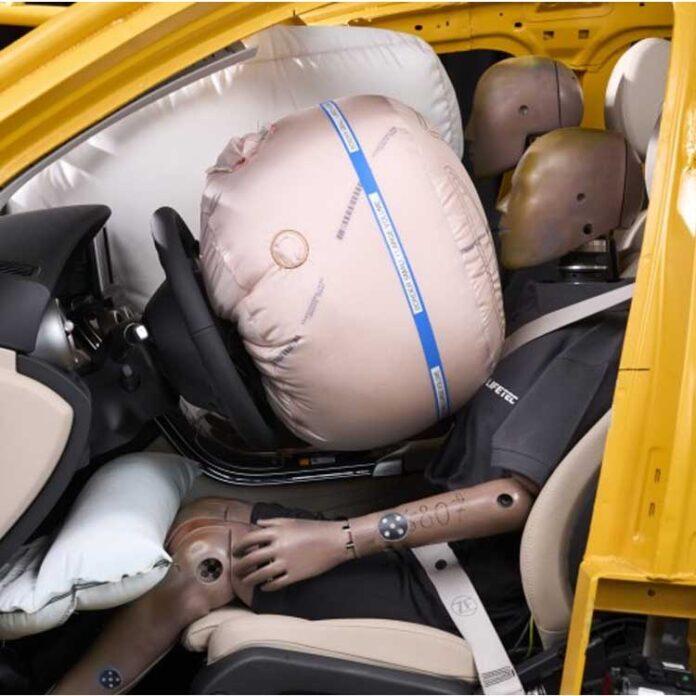
When automated driving becomes a reality, drivers will have flexible seating position options. To provide the best possible protection in the event of a crash, even in comfortable seating positions, new airbag concepts are required that adapt their depth of effect to the respective seating position. ZF LIFETEC has developed a dual contour airbag for the passenger side, which can be inflated in two different sizes, depending on the seating position. ZF LIFETEC is also developing a dual contour airbag for the driver’s side for the next generation of partially or fully automated vehicles.
Level 3 highly automated driving is possible in more vehicles and is being approved in more countries. Drivers can turn away from the traffic when the system is activated – provided they can take back control of the vehicle at any time if they are asked to do so. With fully automated driving at Level 4, this restriction could be removed if the vehicle covers certain sections of the route completely independently. Drivers will also be able to change the seat position and angle of the backrest to a slightly more comfortable seating position if the automated control system takes over the driving task.
For both the driver and front passenger side, occupant protection is only guaranteed for the standard upright seating position. “Our aim is to ensure that occupants in comfort seating positions also enjoy at least the same safety standards they are accustomed to in automated driving,” said Harald Lutz, Head of Development at ZF LIFETEC.
One airbag, two sizes: Crash tests have shown that if a frontal crash occurs while the front occupants are in the comfort seat position – a backrest angle of around 40 degrees – the classic combination of seat belt and airbag may no longer provide optimum protection for the occupants. In this position, the distance between the inflated airbag and the occupant is too great to optimally cushion and restrain the passenger. It is important to note that the 90-degree angle from the backrest to the seat surface is defined as 0 in this recline specification — meaning that the normal seating position is around 20 degrees. With a view to automated driving, a solution is needed that offers a high level of safety for both positions. This is the idea behind the dual contour airbag. Put simply, the solution consists of an airbag that is designed for the standard seating position that can also be enlarged when the occupants are in a comfort seating position.
During development, ZF LIFETEC utilized experience gained from the development of a dual-contour passenger airbag, which will be ready for application this year. The new driver airbag also offers two stages, which extend accordingly depending on whether the person behind the steering wheel is in an upright or comfort seating position. The two-stage function can be regulated via a control unit that switches a system of bag-cushion-tethers. These tethers are connected to an active release unit, which releases them as required.
Inflator for extra volume: In order for the dual-contour driver airbag to fully deploy, the gas filling volume must be increased. This requires a two-stage gas generator, which ZF LIFETEC has developed for airbags with particularly large volumes. It can fill the two volume sizes of the driver airbag integrated in the steering wheel within milliseconds. Lutz emphasizes that this type of airbag can provide a depth adaptivity of approximately 200 mm on the driver’s side. The maximum total inflation volume of a dual-contour airbag is currently achieved on the passenger side and is up to 190 liters, which is unique on the market. “This is the absolute benchmark in this field,” noted Lutz. He emphasized, “ZF LIFETEC thus offers a high level of safety and covers all future requirements in terms of adaptivity.”
Adjusted filling pressure: As the airbag control system is integrated into the car’s electronics, the vehicle can identify which seat position the driver is in at the moment of the crash and which stage of the gas generator needs to be triggered. In addition to seat tilt and weight sensors, other sensors, such as interior cameras, can be integrated into the system for a more precise assessment of the scenario in the interior.
It is possible to implement a further adaptation in the dual-contour airbag. This allows the inflation pressure of the airbag to be varied depending on the size, weight and stature of the occupants. If sensors or interior cameras provide the relevant information and detect a tall, heavy person behind the steering wheel, for example, air vents can be opened to modulate the inflation pressure and thus optimize restraint for the occupant. “With this adaptive system, which ZF LIFETEC already offers in other airbags in series applications, the restraint function of the airbag in many vehicles is already more efficient today and at the same time takes into account the ‘real-life safety’ approach,” summarized Lutz.







